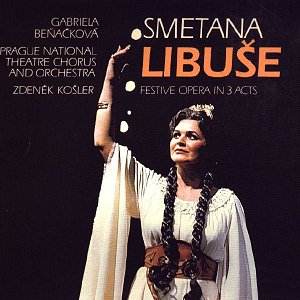'Libuše is not an opera of the old type, but a festive
tableau, a form of musical and dramatic sustenance. I desire it to be
used only for festivals which affect the whole Czech nation.' Smetana's
view of his Libuše was unequivocal, and shows that the whole conception
related to the occasion of its first performance: the inauguration of
the National Theatre in 1881. How fitting then that this performance
should have been recorded live in November 1983 on the theatre's reopening
after a major refurbishment.
There has been another recording subsequently, again
by National Theatre forces but with a different cast, under baton of
Oliver Dohnanyi (Supraphon SU 3200-2). This was also recorded live,
in May 1995, at a performance dedicated to the fiftieth anniversary
of the end of the Second World War. As ever when comparing performances
and recordings of major works, each version has aspects to commend it.
To get back to basics: Dohnanyi's tempi are quicker,
and he takes 150 minutes to Kosler's 166. This is particularly important
because it means two CDs instead of three. The recording sessions were
also more flexible than the straight-through live performance by Kosler,
and the stage noises are not present. On the other hand, the earlier
version has the more atmospheric sound and also the stronger cast, though
special praise is due to Eva Urbanova in the title role of the Dohnanyi
version. Like Gabriela Benackova-Capov for Kosler, she is captured
on splendid form.
The plot is relatively static, and based upon the legendary
events which led to the founding of the first Bohemian dynasty. Libuše
is the Queen of Bohemia, and when there is a dispute over the line of
inheritance, she recommends that the people should decide. This effects
a reconciliation to the delight of all, and in the final scene she prophesies
the glory and eternal life of the Czech nation.
No wonder this opera is never performed on the international
circuit. But the music is another matter, as the stirring opening scene
shows, replete with magnificent fanfares (TRY CD1 1: 0.12). The score
is subtle too, with thematic identification for the main characters,
which allows the personalities of the drama to develop. There are some
fine, noble tunes, to be sure, in particular those for the leading protagonists,
Libuše herself and Premysl. A fine moment comes towards the end when
they make their entrance together, and their two themes are magnificently
combined (CD3 5: 0.00; but be warned, there is discrepancy between the
booklet and CD3 as far as cue points are concerned).
Kosler knows and loves the music, and makes the most
of its monumental style. His relatively slower tempi bring forth the
grandeur and seriousness of the conception, and the ceremonial atmosphere
is well captured by both the recording and the performance (Try the
closing scene of Act 2 CD2 5: 0.00). The cast is splendid, reflecting
that the extraordinary musical traditions of the Czech's (Europe's most
musical nation?) are alive and well. The whole performance captures
the sense of occasion which the reopening of the theatre must have been,
and which links so closely to Smetana's original conception. True, the
audience contributions are too frequent, in the form of both coughing
and applause, and the stage noises are sometimes an irritation. But
for the domestic listener too this opera is an occasional work, and
the atmosphere of occasion is worth having preserved. Both recorded
versions of the work will give pleasure, and while this reissue of the
Kosler performance is by no means perfect, it does reach to the heart
of the matter. Smetana emerges as the great opera composer he undoubtedly
was.
Terry Barfoot


